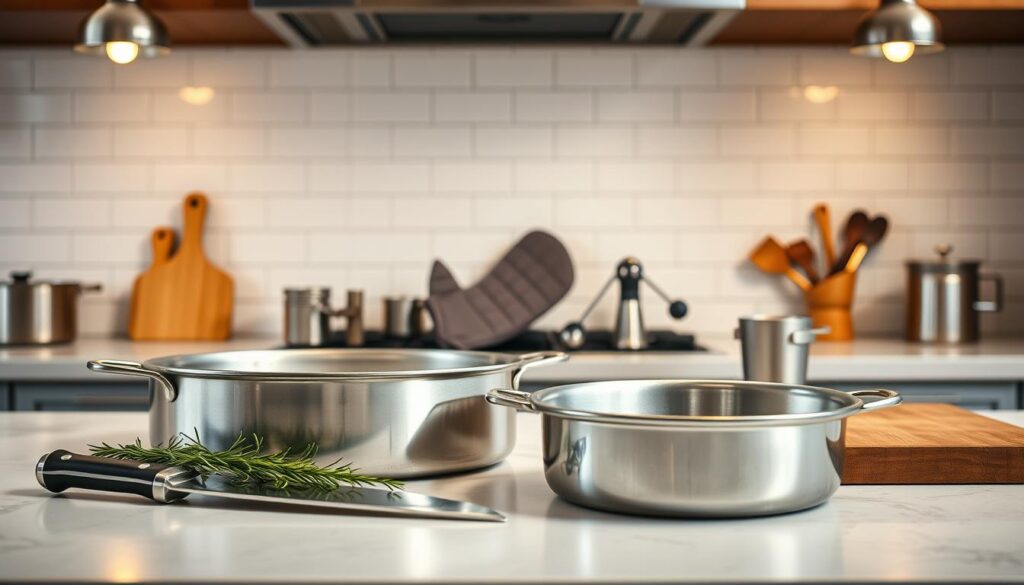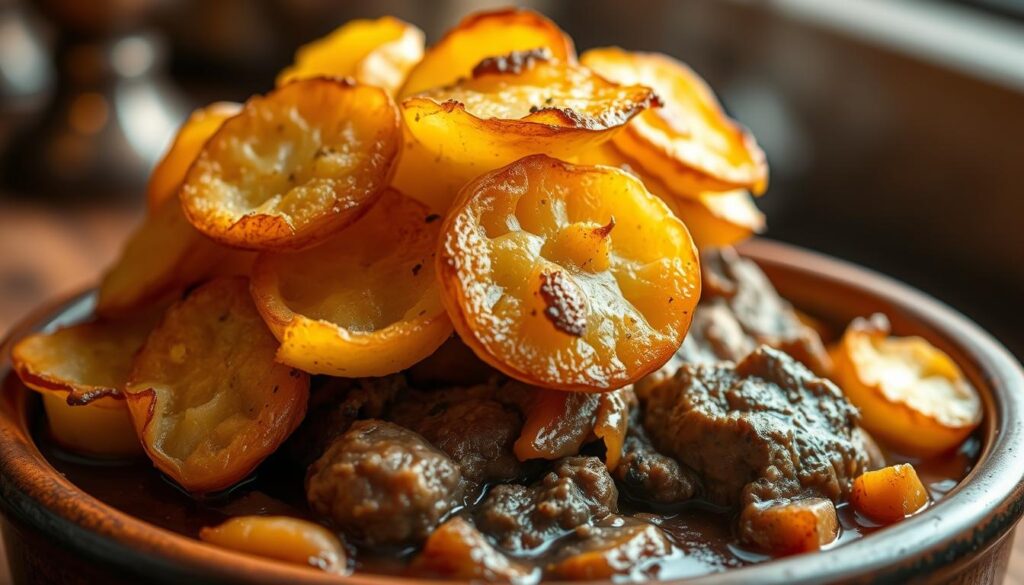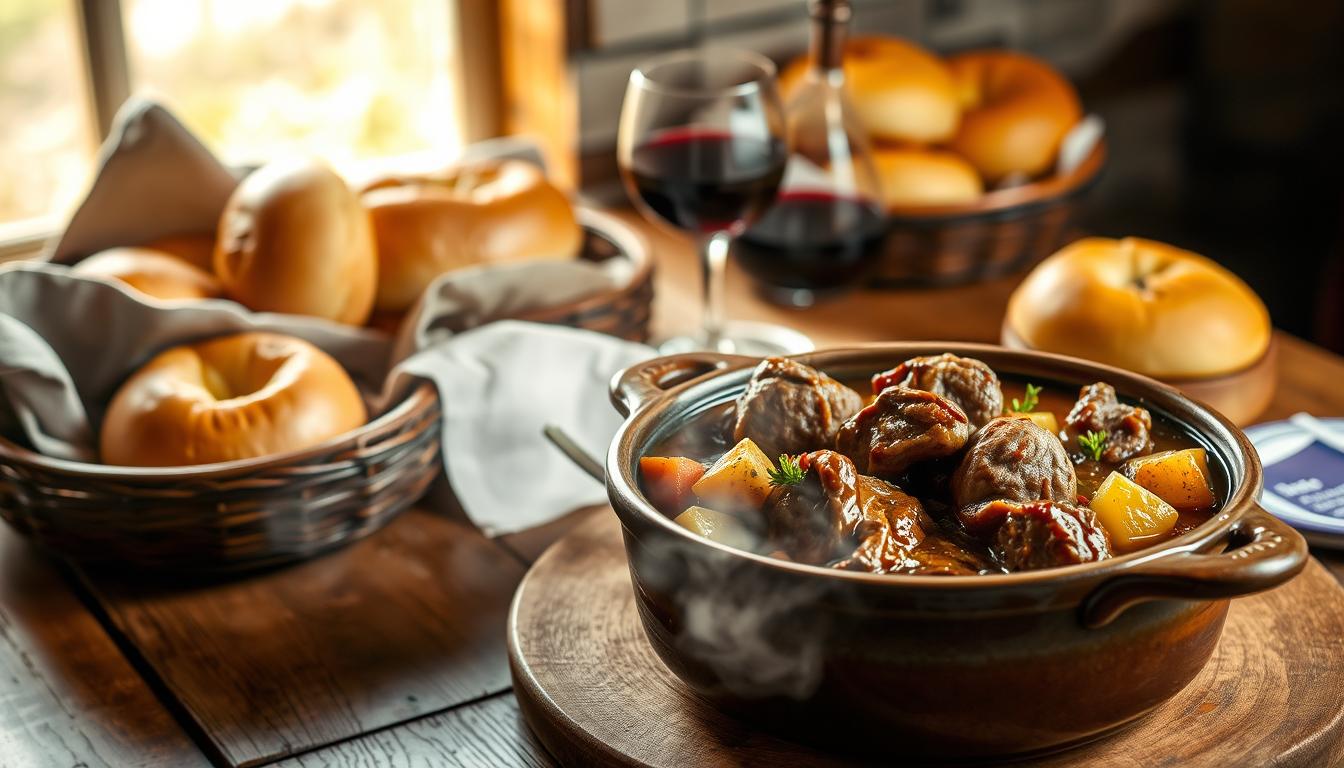On a chilly evening, nothing beats the warmth of a traditional British lamb hotpot. It fills your kitchen with amazing smells. This classic dish brings back memories of family gatherings and cosy Sunday lunches.
It’s more than just a recipe; it’s a journey through British cooking traditions. Whether you’re experienced or new to cooking, this dish will impress you with little effort.
Your journey to making the perfect lamb hotpot starts here. With simple techniques and easy-to-find ingredients, you’ll quickly become a pro. Let’s explore the world of this beloved British comfort food together.
Table of Contents
The Traditional British Heritage of Lancashire Hotpot
The Lamb Hotpot Recipe is a beloved part of British food culture. It comes from the working-class kitchens of Northern England. It shows the value of being resourceful and cooking hearty meals at home.
This iconic dish has its roots in 19th-century Lancashire. Textile workers and miners needed filling, affordable meals. These meals had to be easy to make and packed with nutrients.
Roots in Industrial Lancashire
Lancashire hotpot was a practical choice for families. It had:
- Simple, affordable ingredients
- One-pot cooking method
- Ability to slowly cook while workers were away
- Nutritious combination of lamb, potatoes, and vegetables
Culinary Evolution
Over time, the Lancashire hotpot became a national favourite. Restaurants and home cooks now celebrate this classic dish. They keep its cultural heritage alive while updating it for today’s tastes.
A true testament to British culinary ingenuity, the Lancashire hotpot continues to warm hearts and stomachs across generations.
The Lancashire hotpot’s lasting appeal shows how local dishes can become national treasures. It bridges social gaps and wins hearts everywhere.
Essential Ingredients for the Perfect Lamb Hotpot Recipe
To make a great lamb hotpot, you need the right ingredients. These ingredients turn a simple meal into a hearty dish. The secret is in picking the perfect mix that works well together.
- Lamb Cuts: Choose shoulder or neck cuts for rich, tender meat
- Potatoes for a crispy golden topping
- Root vegetables like carrots and parsnips
- Onions for depth of flavour
- Fresh herbs such as thyme and rosemary
When making your lamb and vegetable hotpot, keep these tips in mind:
- Choose high-quality, preferably local lamb
- Use seasonal vegetables for maximum flavour
- Include a rich stock or gravy base
“The secret to an exceptional hotpot is in the quality of ingredients and the love you pour into cooking.” – Traditional Lancashire Cook
Every ingredient is important for the flavours in a lamb hotpot. Your choice of vegetables and seasonings can make it your own. This way, you can enjoy a traditional dish that suits your taste.
Selecting and Preparing Your Lamb Cuts
Choosing the right lamb cut is key to a great hotpot. The cut you pick affects the taste and texture of your dish. Knowing about different lamb cuts can make your meal truly special.
For a delicious hotpot, pick the right lamb cut. Each part of the lamb has its own special qualities. These can make your dish stand out.
Best Cuts for Hotpot Cooking
- Shoulder: Rich in flavour and perfect for slow cooking
- Leg: Lean meat with excellent texture
- Shanks: Incredibly tender when braised
Trimming and Portioning Guidelines
When preparing your lamb, remove excess fat but keep some for flavour. Cut the meat into chunks of 2-3 cm. This helps it cook evenly and soak up marinades better.
Marinating Techniques for Enhanced Flavour
Marinating makes your lamb truly special. Mix herbs like rosemary, thyme, and garlic into a marinade. Let the lamb marinate for at least two hours, or overnight, for deep flavours.
- Use olive oil as a base
- Add fresh herbs and spices
- Include a splash of red wine for depth
Pro tip: Always let your marinated lamb come to room temperature before cooking. This ensures even cooking and tenderness.
Kitchen Equipment and Preparation Steps
To make a tasty one-pot lamb recipe, you need the right tools and a plan. Choosing the right equipment and setting up your kitchen well is key to a great lamb hotpot.

- Large Dutch oven or deep casserole dish
- Sharp chef’s knife
- Cutting board
- Measuring cups and spoons
- Wooden spoon or silicon spatula
Getting ready is important for a perfect one-pot lamb recipe. First, collect all your ingredients and tools before you start cooking. This makes the cooking process smooth and stress-free.
| Equipment | Purpose | Recommended Type |
|---|---|---|
| Casserole Dish | Primary cooking vessel | Cast iron or ceramic |
| Knife | Ingredient preparation | High-carbon stainless steel |
| Chopping Board | Safe cutting surface | Wooden or plastic |
When you’re making your lamb casserole, keep your workspace clean and tidy. Chop veggies early, trim the lamb meat carefully, and have your seasonings ready. Mise en place is essential for a successful one-pot lamb recipe.
Pro tip: Use a heavy-bottomed dish that can go from stovetop to oven. This makes cooking your lamb hotpot easier and more efficient.
Step-by-Step Guide to Making Your Lamb Hotpot
Making a delicious lamb stew needs precision and care. Your hearty lamb meal will turn into a comforting dish. This happens through careful preparation and cooking techniques.
Mastering lamb hotpot involves several key steps. These steps ensure a tasty result.
Layering Techniques for Optimal Flavour
The secret to a great lamb hotpot is in layering. Follow these important guidelines:
- Start with a base of seasoned lamb pieces
- Create alternating layers of meat and root vegetables
- Ensure even distribution of ingredients
- Season each layer lightly with salt and pepper
Precise Temperature and Timing Controls
Slow cooking is key to rich flavours in your lamb stew. Use this temperature guide:
| Cooking Stage | Temperature | Approximate Time |
|---|---|---|
| Initial Browning | 200°C | 15 minutes |
| Slow Cooking | 160°C | 2-3 hours |
Vegetable Integration Techniques
Vegetables are vital in your hearty lamb meal. Here are tips for perfect vegetable inclusion:
- Cut vegetables into uniform chunks
- Add root vegetables at the beginning of cooking
- Include softer vegetables during the last hour
- Ensure vegetables maintain their texture
“The magic of a great lamb hotpot is in the patient layering and gentle cooking.” – Traditional British Chef
By following these detailed steps, you’ll make a lamb hotpot that’s both authentic and full of flavour.
Tips for Achieving the Perfect Crispy Potato Topping

Creating the perfect crispy potato topping is key for a great lamb hotpot. This golden-brown layer adds texture and looks amazing.
Choosing the right potatoes is important. Go for starchy types like Maris Piper or King Edward. They crisp up well and contrast nicely with the lamb.
- Slice potatoes thinly and uniformly (about 3-4mm thick)
- Arrange potato slices in overlapping layers
- Brush each layer with melted butter or olive oil
- Season with sea salt and cracked black pepper
To get that crispiness, follow these steps:
- Preheat your oven to 200°C (fan setting)
- Start cooking covered for the first 45 minutes
- Remove the lid for the final 30-40 minutes
- Watch carefully to prevent burning
Using a cast-iron casserole dish is a good idea. It spreads heat evenly and helps get that golden crust. Adding grated cheese on top in the last stage adds extra flavour.
The secret to an exceptional lamb hotpot lies in the potato topping’s crisp, golden perfection.
Wine Pairing and Serving Suggestions
Improving your traditional British lamb dish is all about the right sides and wine. The perfect choice can turn your lamb hotpot into a special meal.
A good wine can make your lamb meal even better. It brings out the rich flavours of this classic comfort food.
Complementary Side Dishes
Think about these sides for your lamb dish:
- Crisp green salad with light vinaigrette
- Steamed seasonal vegetables
- Crusty artisan bread
- Pickled red cabbage
Best Wine Selections
Finding the right wine can take your lamb hotpot to the next level. Here are some top picks:
| Wine Type | Flavour Profile | Recommended Pairing |
|---|---|---|
| Bordeaux Blend | Rich, full-bodied | Ideal for robust lamb flavours |
| Syrah/Shiraz | Spicy, dark fruit notes | Matches hotpot’s deep flavours |
| Pinot Noir | Light, elegant | Complements tender lamb |
Pro tip: Serve your wine a bit cooler than room temperature. This brings out the best in both the dish and the wine.
Storage and Reheating Guidelines
Keeping your lamb casserole fresh is key. After you’ve enjoyed it, make sure the leftovers stay good for later meals.
First, cool your lamb hotpot down. Let it cool at room temperature for up to two hours. This stops bacteria from growing and keeps the flavours strong.
- Store in an airtight container
- Refrigerate within two hours of cooking
- Use within 3-4 days for optimal taste
Choose glass or ceramic containers with tight lids for the fridge. These keep the flavours in and prevent moisture loss.
Reheating needs to be done carefully. Here’s how:
- Remove from fridge 30 minutes before reheating
- Preheat oven to 180°C
- Cover with foil to prevent drying
- Heat until internal temperature reaches 74°C
Tip: Your lamb stew might taste even better the next day. Leftovers can be a real treat.
“A well-stored lamb hotpot is a culinary treasure waiting to be rediscovered.” – Traditional British Cooking Wisdom
For longer storage, freeze your lamb casserole for up to three months. Use freezer-safe containers and leave space for the liquid to expand when it freezes.
Conclusion
Learning to make lamb hotpot is more than cooking a meal. It’s about connecting with British cooking traditions. You turn simple ingredients into a warm, hearty dish that nourishes both body and soul.
This dish is simple yet versatile. It suits both new cooks and seasoned chefs. By mastering layering, choosing the right lamb, and making a crispy potato top, you’ve learned valuable skills.
When you serve this dish to loved ones, you make memories. The tender lamb, fragrant veggies, and golden potatoes will become a favourite in your kitchen. Enjoy the journey and relish every bite of your homemade lamb hotpot.
Your cooking journey is just starting. You’re about to explore the comfort of classic British home cooking.

